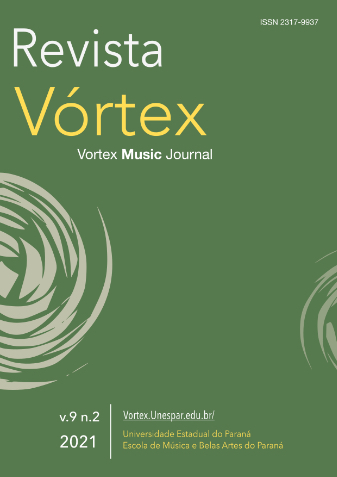Elastic Rhythm in Signal-Synchronised Sequencing Objects for Pure Data
DOI:
https://doi.org/10.33871/23179937.2021.9.2.24Keywords:
polyrhythm, polymeter, sequence, isorhythm, synchronisedAbstract
This paper presents a family of objects for manipulating polyrhythmic sequences and isorhythmic relationships, in both the signal and event domains. These work together and are tightly synchronised to an audio phase signal, so that relative temporal relationships can be tempo-manipulated in a linear fashion. Many permutations of polyrhythmic sequences including incomplete tuplets, scrambled elements, interleaved tuplets and any complex franctional relation can be realised. Similarly, these many be driven with controllable isorhythmic generators derived from a single driver, so that sequences of different fractionally related lengths may be combined and synchronised. It is possible to use signals to drive audio playback that are directly generated, so that disparate sound files may be combined into sequences. A set of sequenced parameters are included to facilitate this process.Downloads
References
KELLY, Edward. Time in Music: Strategies for Engagement, PhD thesis, University of East Anglia, July 2005, pp88-98. http://sharktracks.co.uk/ed/epk_thesis.pdf
KRAMER, Jonathan D. The Time of Music, New Meanings, New Temporalities, New Listening Strategies. Macmillan,1988.
MANOURY, Phillipe. The Arrow of Time, Contemporary Music Review, 1:1 pp. 131-145. 1984
PUCKETTE, Miller. Pure Data, In: Proceedings of International Computer Music Conference, Ed. 20, San Francisco, 1996
READ, Gardner. Modern Rhythmic Notation, Bloomington: Indiana University Press, 1978, pp. 22 onwards.
STOCKHAUSEN, Karlheinz. ...How Time Passes"¦ In: Die Reihe, 3. Massachusetts: Theodore Presser co., English language version, translated by Cornelius Cardew, 1959
Downloads
Published
How to Cite
Issue
Section
License
Copyright (c) 2021 Edward Kelly

This work is licensed under a Creative Commons Attribution 4.0 International License.
Autores mantêm os direitos autorais e concedem à revista o direito de primeira publicação, com o trabalho simultaneamente licenciado sob a Licença Creative Commons Attribution que permite o compartilhamento do trabalho com reconhecimento da autoria e publicação inicial nesta revista.






